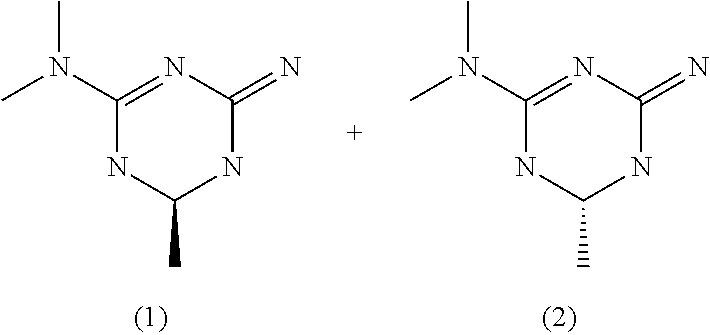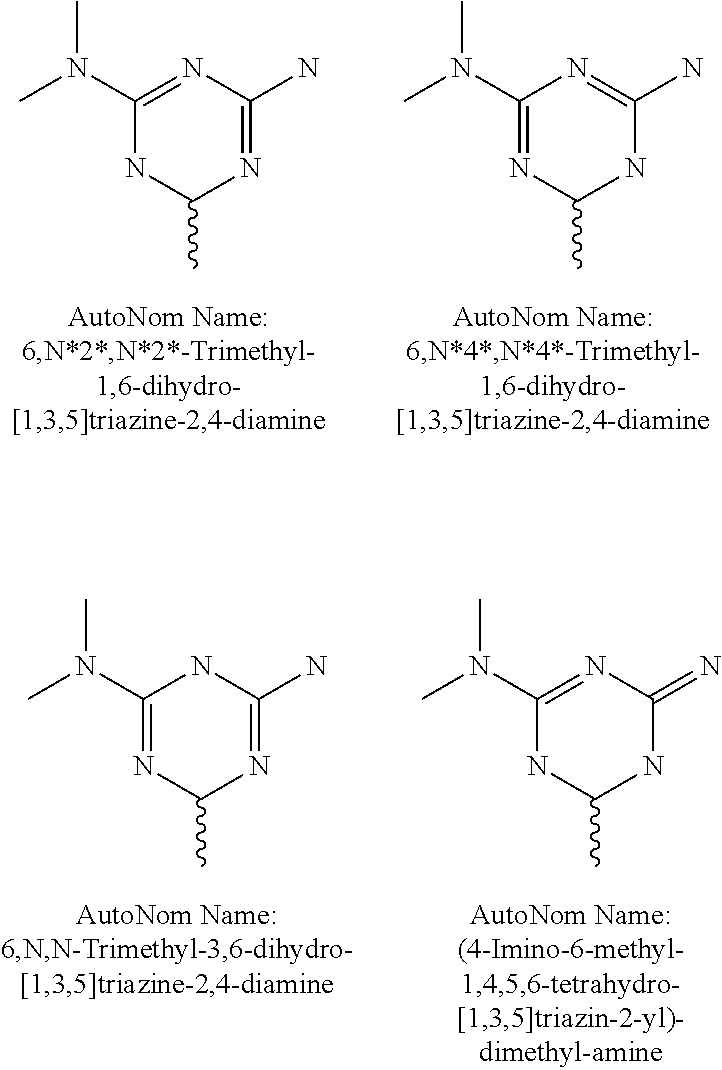Process of isolating enantiomer components from enantiomer mixtures by particle-size-controlled crystallization
a technology of enantiomer and mixture, which is applied in the field of isolating enantiomer components from a mixture of enantiomer through particle size control crystallization, can solve the problems of lack of selectivity, inability to economically isolate some enantiomers in commercial quantities, and difficulty in isolating enantiomers from a mixture of enantiomers
- Summary
- Abstract
- Description
- Claims
- Application Information
AI Technical Summary
Benefits of technology
Problems solved by technology
Method used
Image
Examples
example 1
Isolation of enantiomers of (4-Imino-6-methyl-1,4,5,6-tetrahydro-[1,3,5]triazin-2-yl)-dimethylamine hydrochloride
First Step—Particle-Size-Controlled-Crystallization:
[0045]1,1 kg ((R)-(4-Imino-6-methyl-1,4,5,6-tetrahydro-[1,3,5]triazin-2-yl)-dimethylamine hydrochloride / ((S)-(4-Imino-6-methyl-1,4,5,6-tetrahydro-[1,3,5]triazin-2-yl)-dimethylamine hydrochloride racemate is dissolved in 5,5 kg Ethanol and the resulting solution is carefully stirred with a metallic propeller (angle ˜45°, 150 rpm) and cooled down to 55° C. for seeding. 70 g ((R)-(4-Imino-6-methyl-1,4,5,6-tetrahydro-[1,3,5]triazin-2-yl)-dimethylamine hydrochloride crystals (sieve-size >300 μm) are added, and it is then isothermally stirred for 30 min before seeding with 15 g ((S)-(4-Imino-6-methyl-1,4,5,6-tetrahydro-[1,3,5]triazin-2-yl)-dimethylamine hydrochloride crystals (sieve-size <59 μm) and further 30 min stirring at 55° C.
[0046]The mixture is finally carefully cooled down with a slow programmed ramp:[0047]−0.07 K / min...
example 2
Isolation of Enantiomers of Hydroxybenzoin
First Step—Particle-Size-Controlled-Crystallization:
[0059]20 g (R,R)-hydrobenzoin / (S,S)-hydrobenzoin racemate is dissolved in 80 g Ethanol and the resulting solution is carefully stirred with a teflon propeller (angle ˜45°, 180 rpm) and cooled down to 34.4° C. for seeding. 1 g (S,S)-hydrobenzoin crystals (sieve-size >500 μm) are added, the mixture is then isothermally stirred for 1 h before seeding with 0.2 g (R,R)-hydrobenzoin crystals (sieve-size <59 μm) and further 1 h stirring at 34° C.
[0060]The mixture is finally carefully cooled down with a slow programmed ramp:[0061]−0.05 K / min until 25.5° C., fast heating up to 27.4° C. and 30 min stirring at 27.4° C.[0062]−0.05 K / min until 15.3° C., fast heating up to 17.7° C. and 30 min stirring at 17.7° C.[0063]−0.05 K / min until 5.7° C., fast heating up to 7.8° C. and 30 min stirring at 7.8° C.[0064]−0.05 K / min until −13.6° C.
[0065]As soon as the final temperature of −13.6° C. is reached, the comp...
PUM
| Property | Measurement | Unit |
|---|---|---|
| temperature | aaaaa | aaaaa |
| temperature | aaaaa | aaaaa |
| angle | aaaaa | aaaaa |
Abstract
Description
Claims
Application Information
 Login to View More
Login to View More - R&D
- Intellectual Property
- Life Sciences
- Materials
- Tech Scout
- Unparalleled Data Quality
- Higher Quality Content
- 60% Fewer Hallucinations
Browse by: Latest US Patents, China's latest patents, Technical Efficacy Thesaurus, Application Domain, Technology Topic, Popular Technical Reports.
© 2025 PatSnap. All rights reserved.Legal|Privacy policy|Modern Slavery Act Transparency Statement|Sitemap|About US| Contact US: help@patsnap.com



